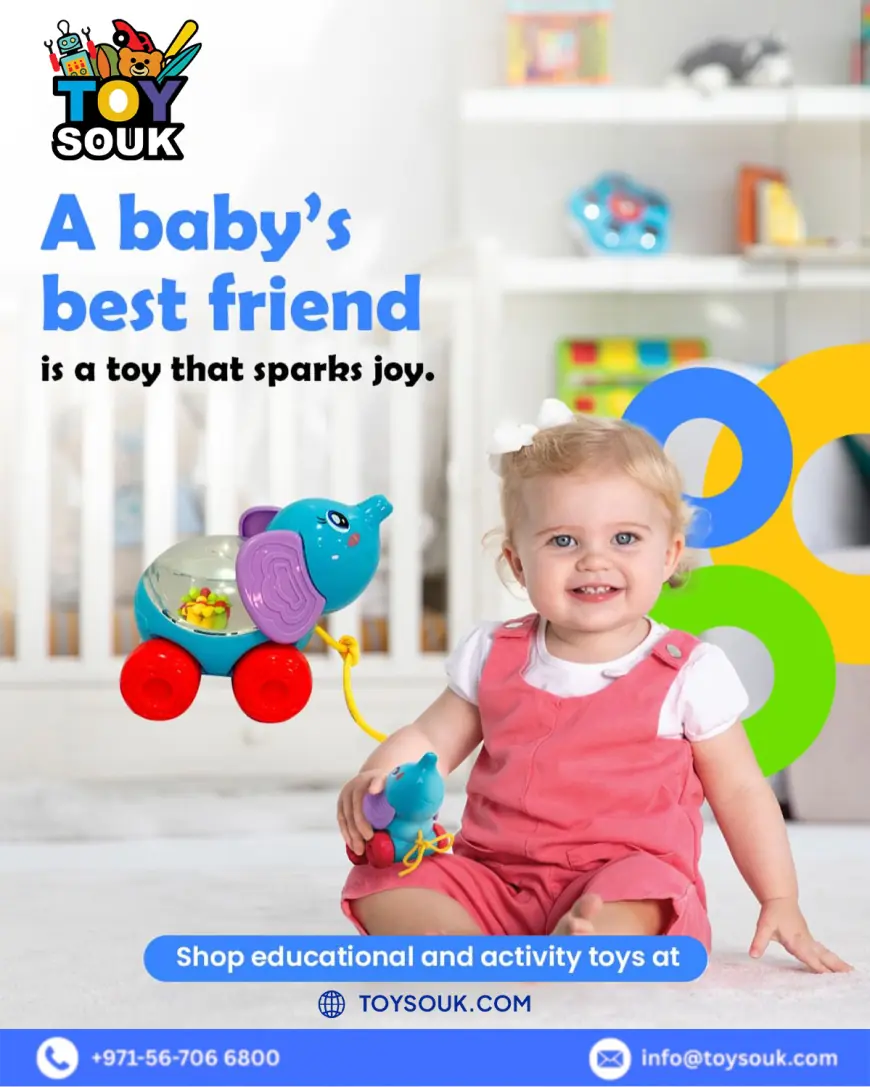How to Choose Toddler Toys That Build Fine Motor Skills in a Modern Way

The best way to choose toddler toys that build fine motor skills in a modern way is to focus on toys that combine hands-on activities with creativity, problem-solving, and sensory experiences. Instead of just picking toys that keep children busy, today’s parents can select toys that actively strengthen little fingers, hand-eye coordination, and cognitive growth, while still being fun and engaging.
Why Fine Motor Skills Matter So Much
Fine motor skills are the small, precise movements toddlers make with their hands, wrists, and fingers. These skills might look simple — holding a spoon, stacking blocks, or scribbling with a crayon — but they form the foundation for future abilities like writing, dressing independently, or using tools.
Research shows that children who develop fine motor skills early often have an easier time with school readiness. In fact, a 2018 study published in Early Childhood Research Quarterly found that preschoolers with strong fine motor coordination scored higher in literacy and math assessments. So, when you buy a toy for your toddler, you’re not just entertaining them — you’re helping shape their future learning abilities.
What Does “Modern” Mean When It Comes to Toddler Toys?
In the past, fine motor development focused mainly on stacking blocks or threading beads. While those classics still matter, modern parenting calls for toys that:
- Blend learning with play – Toys that are educational without feeling like lessons.
- Encourage creativity – Open-ended play where kids aren’t told exactly what to do.
- Use safe, eco-friendly designs – Parents today prefer sustainable and non-toxic materials.
- Adapt to tech realities – Minimal screen use but sometimes incorporating interactive elements thoughtfully.
So, “modern” doesn’t mean digital screens everywhere. It means toys that fit today’s world — safe, flexible, and aligned with what parents want most: smarter, healthier play.
How to Identify the Right Fine Motor Skill Toys
When shopping for toddler toys, here’s what you should look out for:
1. Toys That Require Grasping
Toddlers learn by picking things up and holding them. Toys like chunky puzzles, stacking cups, or soft blocks encourage children to strengthen their grip and finger control.
2. Toys That Involve Pinching or Pincer Grip
Activities like using toy tweezers, inserting pegs into a board, or fitting small puzzle pieces help toddlers refine their pincer grasp — the same movement they’ll later use to hold a pencil.
3. Toys That Encourage Hand-Eye Coordination
Whether it’s tossing a ball into a hoop or placing shapes into matching slots, toys that make toddlers match sight with movement are gold for development.
4. Toys That Allow Creative Freedom
Fine motor skills develop fastest when children don’t just copy instructions but invent their own play. Art toys, modeling clay, or magnetic tiles allow endless variations, strengthening both the mind and the hands.
5. Toys That Grow With the Child
The smartest investment is choosing toys that adapt. A toy kitchen, for example, starts as simple pretend play but soon becomes a way to practice pouring, stirring, and using tools — all requiring controlled hand movements.
Examples of Modern Toys That Build Fine Motor Skills
Let’s dive into specific toy categories that help toddlers refine their motor skills in meaningful, up-to-date ways.
Building and Stacking Toys
Classic blocks never go out of style, but today’s versions come in safer, lighter, and more versatile forms. Magnetic tiles, for example, let toddlers build towers without frustration, while eco-friendly wooden blocks add texture and sensory variety.
Puzzles and Shape Sorters
Puzzles & Games Toys are perfect for strengthening problem-solving along with hand movements. Chunky wooden puzzles, knobbed puzzles, and shape sorters all make toddlers practice fitting objects precisely.
Arts and Crafts Toys
Finger paints, chunky crayons, and playdough kits are some of the best ways to encourage hand strength. Rolling, squishing, and molding clay is both soothing and skill-building.
Pretend Play Toys
From toy kitchens to doctor kits, pretend play often requires small movements: stirring in a pot, clipping a toy stethoscope, or fastening velcro on pretend food. These everyday role-play activities mirror real-life skills and improve dexterity.
Musical Toys
Instruments like toddler-sized keyboards, xylophones, or maracas get fingers moving in rhythm. Music naturally improves coordination while sparking joy.
Balancing Fun and Development
Parents sometimes worry that focusing on skills makes play feel like homework. The trick is to choose educational toys for kids that are so engaging, toddlers don’t even realize they’re practicing.
Take stacking rings, for instance: a child may think they’re just building a colorful tower, but in reality, they’re developing grip strength, spatial awareness, and patience. The best toys make development feel like magic, not effort.
Real-Life Examples: What Works for Toddlers Today
- Case Study: The Montessori-Inspired Family
A Dubai-based mom shared that switching to open-ended Montessori toys helped her toddler become calmer and more focused. Simple wooden toys, combined with daily play routines, boosted both independence and hand control. - Expert Insight: Pediatric Occupational Therapists
Experts often recommend toys that make kids “work a little.” For example, using play tweezers to move pom-poms isn’t just fun — it strengthens the same muscles needed for self-feeding. - Stat Snapshot
According to a 2022 report by The Toy Association, over 60% of parents now prioritize educational value when buying toddler toys. This shift shows a clear trend toward toys that merge skill-building with play.
Avoiding Common Mistakes When Buying Fine Motor Toys
- Mistake 1: Buying for Age Labels Alone
Age guidelines are useful, but every child develops differently. Choose toys slightly above your toddler’s comfort level to gently challenge them. - Mistake 2: Overloading with Too Many Toys
Research suggests children play more creatively when offered fewer toys at a time. A handful of thoughtfully chosen toys often beats a room full of clutter. - Mistake 3: Confusing Digital with “Modern”
While digital games exist for toddlers, experts caution against heavy screen use before age three. Hands-on, tangible play remains the gold standard for fine motor development.
Geo-Relevant Context: Choosing Toys in the UAE
Parents in the UAE have access to a growing range of high-quality, modern toys thanks to the rise of safe and trusted platforms. Whether you’re shopping for toddlers or preschool toys, choosing toys online UAE gives parents the convenience of finding development-friendly options that meet global safety standards without leaving home.
FAQs: Answering Parent Concerns
- What is the best age to start fine motor skill toys?
You can start introducing simple fine motor toys as early as 6–9 months with soft blocks or textured balls. By 1–3 years, more advanced toys like puzzles, stacking sets, and pretend play sets are ideal. - Are electronic toys good for fine motor skills?
Electronic toys with buttons can help, but they often limit creativity. Non-digital, hands-on toys remain more effective for strengthening finger muscles and coordination. - How do I know if a toy is safe?
Look for non-toxic materials, no sharp edges, and pieces too large to be swallowed. Always check for international safety certifications. - My toddler loses interest quickly — is that normal?
Yes. Toddlers have short attention spans. Rotate toys weekly to keep them fresh and engaging. - Can fine motor toys also help with social skills?
Absolutely. Many fine motor toys like building blocks or play kitchens encourage group play, which fosters sharing, cooperation, and communication.
Conclusion: Smarter Play for Stronger Skills
Choosing toddler toys that build fine motor skills in a modern way doesn’t mean filling your home with the latest gadgets or expensive kits. It means being intentional: selecting toys that challenge little hands, spark creativity, and grow alongside your child.
By focusing on grasping, coordination, and open-ended play, you’ll give your toddler more than just entertainment — you’ll prepare them for writing, independence, and problem-solving in everyday life. And in the process, you’ll rediscover the joy of play yourself, watching their tiny hands master big skills one toy at a time.
Source : https://toysouk53.blogspot.com/2025/08/how-to-choose-toddler-toys-that-build.html
Files
What's Your Reaction?
 Like
0
Like
0
 Dislike
0
Dislike
0
 Love
0
Love
0
 Funny
0
Funny
0
 Angry
0
Angry
0
 Sad
0
Sad
0
 Wow
0
Wow
0

















































